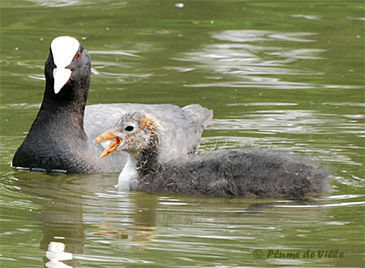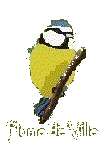Plume de Ville
From day to day.
°°°°°°°°°°°°°°°°°°°°°°° °
May 2009
7 May
All
in pink
flounces, the female flowers, future cones of the terrace spruce.
The "Picea
omorika", serbian
spruce (épinette de Serbie).
The female
flowers sprout only at the top of the tree. Young cones are erect at
the
beginning and then droop.
The male flowers, yellow cylinders, push at the lower levels and appear
on the
branches of precedent years.
Size 2-3cm.
The
two photos of the same cones where taken a week apart (1 and 7 May).
11 May
Belle géomètre...
Latticed
Heath.
[Chiasmia clathrata, Semiothisa clathrata
- Geometridae Ennominae -]
(Géomètre à barreaux,
Réseau)
White wings or more or less yellow, crossed by dark lines.
It is a diurnal moth.
(25mm)
This moth flies in May, June and August September. It overwinters as pupae in the soil.
This one, battered by the wind leaned at right and left in the grass as
a tightrope
walker, keeping its wings half open.
12 May
Cuivre.
The Small Copper.
[Lycaena phlaeas
- Lycaenidae Lycaeninae -]
(Cuivré commun, Bronzé)
Wings orange with red
spots. Hind wings brown with tiny pale blue spots.
It flies from mid-April to late October.
(25mm)
This one
was warming up in the sun, slowly closing and opening the wings.
Hind reverses grey with black spot
(Ph.210409 Plaine de Sorques)
15 May

Small Common Coot mid-April grew up. Their red duvet has almost disappeared. They are fed approximately four weeks by the parents and they will wait another month to fly.
Longhorn moth. [Adela
reaumurella - Adelidae adelinae-]
(Adèle verdoyante)
Long, long antennae,
for this
tiny butterfly. It is the male who has these long clear antennae (more
than
four times its body length), those of the female are shorter.
14-15mm
(Named in
reference to Reaumur (Rene Antoine Ferchault of Réaumur)
known for the alcohol
thermometer but who was also one of the first great naturalist and
entomologist.)
Hard to fit
in the photo the disproportionate antennas of this male.
They dance in a swarm on the sun around the bushes to find a soul mate.
23 May
Painted lady.
 Painted
lady.
Painted
lady.
[Cynthia cardui or Nymphalidae Vanessa cardui-nymphalinae-) (Vanesse
du
chardon ou Belle dame.)
For
more than a month, they flutter everywhere (on Internet sites too!)
crossing
France (millions?) coming up from the South (North Africa, especially
Morocco)
to the north of Europe.
It
is a migratory butterfly. It will lay in the north, but it will not see
again
the sun of the South. It is its offspring which will go back to the
south. The
migration of this year is particularly exceptional.
It
is a wonderful spectacle to see for hours; these butterflies fly at
full
speed in small groups of 2-4, in the same direction (west / northwest
to those
ones).
They
continue their flight, regardless of obstacles, pass nearby and coming
from all
sides. It's impressive to see them, all in the same direction at high
speed.
Few stop, they think only to fly to their goal.
This
one may be exhausted, landed in the rocks and stayed there a long time.
It
alighted where the heat is greatest, to regain his strength. It has
struggled to resume its flight, trying to take off several times and
return to
heat. Finally he managed to resume its course, immediately aiming
to
the same
direction as the others.
Very
few
stop to sip nectar, which they take quickly, almost on the sly, before
resuming
their flight. We have to take the picture quickly. Some have wings in
poor
condition.
In
the evening, they will stop in a tree in a garden to fly in the morning.
(Click to enlarge)
(Pictured in Seine-et-Marne, the 200509. Present in Paris where I saw them today).
http://www.zoologie.vd.ch/1_actualite/AcDChA.html
http://www.enviscope.com/17278-Belle-dame-papillon-migration.html
24 May
This morning there were several of them alighted for breakfast on my cosmos.



















